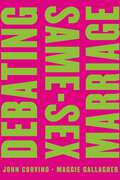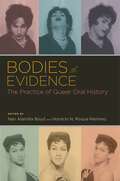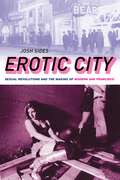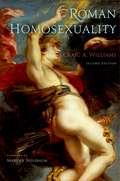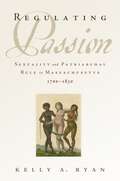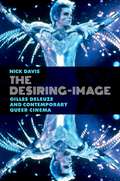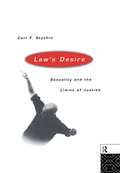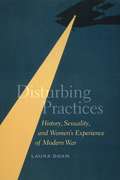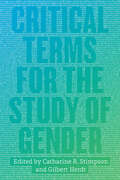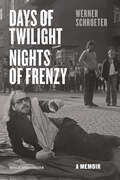- Table View
- List View
Debating Same-Sex Marriage (Point/Counterpoint)
by John Corvino Maggie GallagherPolls and election results show Americans sharply divided on same-sex marriage, and the controversy is unlikely to subside anytime soon. Debating Same-Sex Marriage provides an indispensable roadmap to the ongoing debate. Taking a "point/counterpoint" approach, John Corvino (a philosopher and prominent gay advocate) and Maggie Gallagher (a nationally syndicated columnist and co-founder of the National Organization for Marriage) explore fundamental questions: What is marriage for? Is sexual difference essential to it? Why does the government sanction it? What are the implications of same-sex marriage for children's welfare, for religious freedom, and for our understanding of marriage itself? While the authors disagree on many points, they share the following conviction: Because marriage is a vital public institution, this issue deserves a comprehensive, rigorous, thoughtful debate.
Bodies of Evidence: The Practice of Queer Oral History (Oxford Oral History Series)
by Nan Alamilla Boyd Horacio N. Roque RamirezBodies of Evidence: The Practice of Queer Oral History is the first book to provide serious scholarly insight into the methodological practices that shape lesbian, gay, bisexual, transgender, and queer oral histories. Each chapter pairs an oral history excerpt with an essay in which the oral historian addresses his or her methods and practices. With an afterword by John D'Emilio, this collection enables readers to examine the role memory, desire, sexuality, and gender play in documenting LGBTQ communities and cultures. The historical themes addressed include 1950s and '60s lesbian bar culture; social life after the Cuban revolution; the organization of transvestite social clubs in the U.S. midwest in the 1960s; Australian gay liberation activism in the 1970s; San Francisco electoral politics and the career of Harvey Milk; Asian American community organizing in pre-AIDS Los Angeles; lesbian feminist "sex war" cultural politics; 1980s and '90s Latina/o transgender community memory and activism in San Francisco; and the war in Iraq and Afghanistan. The methodological themes include questions of silence, sexual self-disclosure and voyeurism, the intimacy between researcher and narrator, and the social and political commitments negotiated through multiple oral history interviews. The book also examines the production of comparative racial and sexual identities and the relative strengths of same-sexuality, cross-sexuality, and cross-ideology interviewing.
Erotic City: Sexual Revolutions and the Making of Modern San Francisco
by Josh SidesSince the 1960s, San Francisco has been America's capital of sexual libertinism and a potent symbol in its culture wars. In this highly original book, Josh Sides explains how this happened, unearthing long-forgotten stories of the city's sexual revolutionaries, as well as the legions of longtime San Franciscans who tried to protect their vision of a moral metropolis. Erotic dancers, prostitutes, birth control advocates, pornographers, free lovers, and gay libbers transformed San Francisco's political landscape and its neighborhoods in ways seldom appreciated. But as sex radicals became more visible in the public spaces of the city, many San Franciscans reacted violently. The assassinations of Mayor George Moscone and Supervisor Harvey Milk were but the most brazen acts in a city caught up in a battle over morality. Ultimately, Sides argues, one cannot understand the evolution of postwar American cities without recognizing the profound role that sex has played. More broadly, one cannot understand modern American politics without taking into account the postwar transformation of San Francisco and other cities into both real and imagined repositories of unfettered sexual desire.
Roman Homosexuality: Second Edition
by Craig A. WilliamsTen years after its original publication, Roman Homosexuality remains the definitive statement of this interesting but often misunderstood aspect of Roman culture. Learned yet accessible, the book has reached both students and general readers with an interest in ancient sexuality. This second edition features a new foreword by Martha Nussbaum, a completely rewritten introduction that takes account of new developments in the field, a rewritten and expanded appendix on ancient images of sexuality, and an updated bibliography.
Bodies of Evidence: The Practice of Queer Oral History (Oxford Oral History Series)
by Nan Alamilla Boyd, Horacio N. Roque RamírezBodies of Evidence: The Practice of Queer Oral History is the first book to provide serious scholarly insight into the methodological practices that shape lesbian, gay, bisexual, transgender, and queer oral histories. Each chapter pairs an oral history excerpt with an essay in which the oral historian addresses his or her methods and practices. With an afterword by John D'Emilio, this collection enables readers to examine the role memory, desire, sexuality, and gender play in documenting LGBTQ communities and cultures. The historical themes addressed include 1950s and '60s lesbian bar culture; social life after the Cuban revolution; the organization of transvestite social clubs in the U.S. midwest in the 1960s; Australian gay liberation activism in the 1970s; San Francisco electoral politics and the career of Harvey Milk; Asian American community organizing in pre-AIDS Los Angeles; lesbian feminist "sex war" cultural politics; 1980s and '90s Latina/o transgender community memory and activism in San Francisco; and the war in Iraq and Afghanistan. The methodological themes include questions of silence, sexual self-disclosure and voyeurism, the intimacy between researcher and narrator, and the social and political commitments negotiated through multiple oral history interviews. The book also examines the production of comparative racial and sexual identities and the relative strengths of same-sexuality, cross-sexuality, and cross-ideology interviewing.
Regulating Passion: Sexuality and Patriarchal Rule in Massachusetts, 1700-1830
by Kelly A. RyanSexuality was critical to how individuals experienced, learned, and contested their place in early America. Regulating Passion shows the sweeping changes that affected the social and political morass centered on sexual behavior during the late eighteenth and early nineteenth centuries in Massachusetts-even as patriarchy remained important to those configurations of power. Charting the government's and society's management of sexuality, Kelly A. Ryan uncovers the compelling stories of the individuals charged with sexual crimes and how elites hoped to contain and exploit "illicit" sexual behavior. In the colonial era, elites designed laws, judicial and religious practices, and sermons that defined certain groups as criminal, the cause of sexual vice, and in need of societal oversight-while defining others as chaste and above reproach. Massachusetts fornicators, adulterers, seducers, and rapists were exemplars of improper behavior in the colonial era and were central to emerging sexual subjectivities associated with gender, race, and class status in the early republic. As Massachusetts modernized, culture and socialization became vehicles for enforcing the marital monopoly on sex and gendered expectations of sexual behavior. The American Revolution saw the decline of direct sexual regulation by government and religious institutions and a rise in the importance of sexual reputation in maintaining hierarchy. As society moved away from publicly penalizing forms of illicit sexual behavior, it circulated ideas about sexual norms, initiated social ostracism, and interceded with family and friends to promote sexual morality, even as the government remained involved in cases of prostitution and interracial sex. At the same time, this transformation in sexual regulation opened up means to contest the power of patriarchy. Women, African Americans, Indians, and the poor often resisted the efforts of elites and established their own code of sexual conduct to combat ideas about what constituted sexual virtue and how society defined its leaders. They challenged derisive sexual characterizations, patriarchal visions of society, and sexual regulation to establish a space in the body politic. Ironically, their efforts often reinforced patriarchal ideals as their petitions asked for patriarchal privileges to be extended to them. Based on records of crimes in lower and upper courts, print literature, and other documentary sources, Regulating Passion underscores the ways in which sexual mores remained essential to the project of differentiating between the virtue of citizens and contesting power structures in the tumultuous transitions from the colonial to early national period.
Debating Same-Sex Marriage (Point/Counterpoint)
by Maggie Gallagher John CorvinoPolls and election results show Americans sharply divided on same-sex marriage, and the controversy is unlikely to subside anytime soon. Debating Same-Sex Marriage provides an indispensable roadmap to the ongoing debate. Taking a "point/counterpoint" approach, John Corvino (a philosopher and prominent gay advocate) and Maggie Gallagher (a nationally syndicated columnist and co-founder of the National Organization for Marriage) explore fundamental questions: What is marriage for? Is sexual difference essential to it? Why does the government sanction it? What are the implications of same-sex marriage for children's welfare, for religious freedom, and for our understanding of marriage itself? While the authors disagree on many points, they share the following conviction: Because marriage is a vital public institution, this issue deserves a comprehensive, rigorous, thoughtful debate.
The Desiring-Image: Gilles Deleuze and Contemporary Queer Cinema
by Nick DavisThe Desiring-Image yields new models of queer cinema produced since the late 1980s, based on close formal analysis of diverse films as well as innovative contributions to current film theory. The book defines "queer cinema" less as a specific genre or in terms of gay and lesbian identity, but more broadly as a kind of filmmaking that conveys sexual desire and orientation as potentially fluid within any individual's experience, and as forces that can therefore unite unlikely groups of people along new lines, socially, sexually, or politically. The films driving this analysis range from celebrated fixtures of the New Queer Cinema of the 1990s (including Cheryl Dunye's The Watermelon Woman and Todd Haynes's Velvet Goldmine) to sexually provocative films of the same era that are rarely classified as queer (David Cronenberg's Dead Ringers and Naked Lunch) to breakout films by 21st-century directors (Rodney Evans's Brother to Brother, John Cameron Mitchell's Shortbus). To frame these readings and to avoid heterosexist assumptions in other forms of film analysis, The Desiring-Image revisits the work of the philosopher Gilles Deleuze, whose two major works on cinema somehow never address the radical ideas about desire he expresses in other texts. This book brings those notions together in innovative ways, making them clear and accessible to newcomers and field specialists alike, with clear, illustrated examples drawn from a wide range of movies extending beyond the central case studies. Thus, The Desiring-Image speaks to readers interested in queer and gay/lesbian studies, in film theory, in feminist and sexuality scholarship, and in theory and philosophy, putting those discourses into rich, surprising conversations with popular cinema of the last 30 years.
The Desiring-Image: Gilles Deleuze and Contemporary Queer Cinema
by Nick DavisThe Desiring-Image yields new models of queer cinema produced since the late 1980s, based on close formal analysis of diverse films as well as innovative contributions to current film theory. The book defines "queer cinema" less as a specific genre or in terms of gay and lesbian identity, but more broadly as a kind of filmmaking that conveys sexual desire and orientation as potentially fluid within any individual's experience, and as forces that can therefore unite unlikely groups of people along new lines, socially, sexually, or politically. The films driving this analysis range from celebrated fixtures of the New Queer Cinema of the 1990s (including Cheryl Dunye's The Watermelon Woman and Todd Haynes's Velvet Goldmine) to sexually provocative films of the same era that are rarely classified as queer (David Cronenberg's Dead Ringers and Naked Lunch) to breakout films by 21st-century directors (Rodney Evans's Brother to Brother, John Cameron Mitchell's Shortbus). To frame these readings and to avoid heterosexist assumptions in other forms of film analysis, The Desiring-Image revisits the work of the philosopher Gilles Deleuze, whose two major works on cinema somehow never address the radical ideas about desire he expresses in other texts. This book brings those notions together in innovative ways, making them clear and accessible to newcomers and field specialists alike, with clear, illustrated examples drawn from a wide range of movies extending beyond the central case studies. Thus, The Desiring-Image speaks to readers interested in queer and gay/lesbian studies, in film theory, in feminist and sexuality scholarship, and in theory and philosophy, putting those discourses into rich, surprising conversations with popular cinema of the last 30 years.
Law's Desire: Sexuality And The Limits Of Justice
by Carl StychinThis book is about the relationship between law and desire. More specifically, it is about how sexual desires are constituted and regulated by the law, with particular reference to gay male and, to a lesser extent, lesbian and bisexual sexualities. I attempt to uncover what the law desires- which, I will argue, is the 'homosexual', against whom a coherent heterosexuality can be promoted through law. Throughout the book, I seek to demonstrate that the relationship of law and sexuality is complex and dynamic. While law may be (and has been) a repressive force, it also is a regulatory one which plays a role in constituting and maintaining coherent sexualities. At the same time, regulation is never entirely successful, for gaps and inconsistencies are left within legal discourse. This creates spaces for resistance against, and opposition to, the legal and sexual hegemony. I hope that this book provides one such intervention.
Law's Desire (PDF): Sexuality And The Limits Of Justice
by Carl StychinThis book is about the relationship between law and desire. More specifically, it is about how sexual desires are constituted and regulated by the law, with particular reference to gay male and, to a lesser extent, lesbian and bisexual sexualities. I attempt to uncover what the law desires- which, I will argue, is the 'homosexual', against whom a coherent heterosexuality can be promoted through law. Throughout the book, I seek to demonstrate that the relationship of law and sexuality is complex and dynamic. While law may be (and has been) a repressive force, it also is a regulatory one which plays a role in constituting and maintaining coherent sexualities. At the same time, regulation is never entirely successful, for gaps and inconsistencies are left within legal discourse. This creates spaces for resistance against, and opposition to, the legal and sexual hegemony. I hope that this book provides one such intervention.
Disturbing Practices: History, Sexuality, and Women's Experience of Modern War
by Laura DoanFor decades, the history of sexuality has been a multidisciplinary project serving competing agendas. Lesbian, gay, and queer scholars have produced powerful narratives by tracing the homosexual or queer subject as continuous or discontinuous. Yet organizing historical work around categories of identity as normal or abnormal often obscures how sexual matters were known or talked about in the past. Set against the backdrop of women’s work experiences, friendships, and communities during World War I, Disturbing Practices draws on a substantial body of new archival material to expose the roadblocks still present in current practices and imagine new alternatives. In this landmark book, Laura Doan clarifies the ethical value and political purpose of identity history—and indeed its very capacity to give rise to innovative practices borne of sustained exchange between queer studies and critical history. Disturbing Practices insists on taking seriously the imperative to step outside the logic of identity to address questions as yet unasked about the modern sexual past.
Disturbing Practices: History, Sexuality, and Women's Experience of Modern War
by Laura DoanFor decades, the history of sexuality has been a multidisciplinary project serving competing agendas. Lesbian, gay, and queer scholars have produced powerful narratives by tracing the homosexual or queer subject as continuous or discontinuous. Yet organizing historical work around categories of identity as normal or abnormal often obscures how sexual matters were known or talked about in the past. Set against the backdrop of women’s work experiences, friendships, and communities during World War I, Disturbing Practices draws on a substantial body of new archival material to expose the roadblocks still present in current practices and imagine new alternatives. In this landmark book, Laura Doan clarifies the ethical value and political purpose of identity history—and indeed its very capacity to give rise to innovative practices borne of sustained exchange between queer studies and critical history. Disturbing Practices insists on taking seriously the imperative to step outside the logic of identity to address questions as yet unasked about the modern sexual past.
Disturbing Practices: History, Sexuality, and Women's Experience of Modern War
by Laura DoanFor decades, the history of sexuality has been a multidisciplinary project serving competing agendas. Lesbian, gay, and queer scholars have produced powerful narratives by tracing the homosexual or queer subject as continuous or discontinuous. Yet organizing historical work around categories of identity as normal or abnormal often obscures how sexual matters were known or talked about in the past. Set against the backdrop of women’s work experiences, friendships, and communities during World War I, Disturbing Practices draws on a substantial body of new archival material to expose the roadblocks still present in current practices and imagine new alternatives. In this landmark book, Laura Doan clarifies the ethical value and political purpose of identity history—and indeed its very capacity to give rise to innovative practices borne of sustained exchange between queer studies and critical history. Disturbing Practices insists on taking seriously the imperative to step outside the logic of identity to address questions as yet unasked about the modern sexual past.
Disturbing Practices: History, Sexuality, and Women's Experience of Modern War
by Laura DoanFor decades, the history of sexuality has been a multidisciplinary project serving competing agendas. Lesbian, gay, and queer scholars have produced powerful narratives by tracing the homosexual or queer subject as continuous or discontinuous. Yet organizing historical work around categories of identity as normal or abnormal often obscures how sexual matters were known or talked about in the past. Set against the backdrop of women’s work experiences, friendships, and communities during World War I, Disturbing Practices draws on a substantial body of new archival material to expose the roadblocks still present in current practices and imagine new alternatives. In this landmark book, Laura Doan clarifies the ethical value and political purpose of identity history—and indeed its very capacity to give rise to innovative practices borne of sustained exchange between queer studies and critical history. Disturbing Practices insists on taking seriously the imperative to step outside the logic of identity to address questions as yet unasked about the modern sexual past.
Disturbing Practices: History, Sexuality, and Women's Experience of Modern War
by Laura DoanFor decades, the history of sexuality has been a multidisciplinary project serving competing agendas. Lesbian, gay, and queer scholars have produced powerful narratives by tracing the homosexual or queer subject as continuous or discontinuous. Yet organizing historical work around categories of identity as normal or abnormal often obscures how sexual matters were known or talked about in the past. Set against the backdrop of women’s work experiences, friendships, and communities during World War I, Disturbing Practices draws on a substantial body of new archival material to expose the roadblocks still present in current practices and imagine new alternatives. In this landmark book, Laura Doan clarifies the ethical value and political purpose of identity history—and indeed its very capacity to give rise to innovative practices borne of sustained exchange between queer studies and critical history. Disturbing Practices insists on taking seriously the imperative to step outside the logic of identity to address questions as yet unasked about the modern sexual past.
Disturbing Practices: History, Sexuality, and Women's Experience of Modern War
by Laura DoanFor decades, the history of sexuality has been a multidisciplinary project serving competing agendas. Lesbian, gay, and queer scholars have produced powerful narratives by tracing the homosexual or queer subject as continuous or discontinuous. Yet organizing historical work around categories of identity as normal or abnormal often obscures how sexual matters were known or talked about in the past. Set against the backdrop of women’s work experiences, friendships, and communities during World War I, Disturbing Practices draws on a substantial body of new archival material to expose the roadblocks still present in current practices and imagine new alternatives. In this landmark book, Laura Doan clarifies the ethical value and political purpose of identity history—and indeed its very capacity to give rise to innovative practices borne of sustained exchange between queer studies and critical history. Disturbing Practices insists on taking seriously the imperative to step outside the logic of identity to address questions as yet unasked about the modern sexual past.
Critical Terms for the Study of Gender (Critical Terms)
by Catharine R. Stimpson and Gilbert Herdt“Gender systems pervade and regulate human lives—in law courts and operating rooms, ballparks and poker clubs, hair-dressing salons and kitchens, classrooms and playgroups. . . . Exactly how gender works varies from culture to culture, and from historical period to historical period, but gender is very rarely not at work. Nor does gender operate in isolation. It is linked to other social structures and sources of identity.” So write women’s studies pioneer Catharine R. Stimpson and anthropologist Gilbert Herdt in their introduction to Critical Terms for the Study of Gender, laying out the wide-ranging nature of this interdisciplinary and rapidly changing field. The sixth in the series of “Critical Terms” books, this volume provides an indispensable introduction to the study of gender through an exploration of key terms that are a part of everyday discourse in this vital subject. Following Stimpson and Herdt’s careful account of the evolution of gender studies and its relation to women’s and sexuality studies, the twenty-one essays here cast an appropriately broad net, spanning the study of gender and sexuality across the humanities and social sciences. Written by a distinguished group of scholars, each essay presents students with a history of a given term—from bodies to utopia—and explains the conceptual baggage it carries and the kinds of critical work it can be made to do. The contributors offer incisive discussions of topics ranging from desire, identity, justice, and kinship to love, race, and religion that suggest new directions for the understanding of gender studies. The result is an essential reference addressed to students studying gender in very different disciplinary contexts.
Critical Terms for the Study of Gender (Critical Terms)
by Catharine R. Stimpson Gilbert Herdt“Gender systems pervade and regulate human lives—in law courts and operating rooms, ballparks and poker clubs, hair-dressing salons and kitchens, classrooms and playgroups. . . . Exactly how gender works varies from culture to culture, and from historical period to historical period, but gender is very rarely not at work. Nor does gender operate in isolation. It is linked to other social structures and sources of identity.” So write women’s studies pioneer Catharine R. Stimpson and anthropologist Gilbert Herdt in their introduction to Critical Terms for the Study of Gender, laying out the wide-ranging nature of this interdisciplinary and rapidly changing field. The sixth in the series of “Critical Terms” books, this volume provides an indispensable introduction to the study of gender through an exploration of key terms that are a part of everyday discourse in this vital subject. Following Stimpson and Herdt’s careful account of the evolution of gender studies and its relation to women’s and sexuality studies, the twenty-one essays here cast an appropriately broad net, spanning the study of gender and sexuality across the humanities and social sciences. Written by a distinguished group of scholars, each essay presents students with a history of a given term—from bodies to utopia—and explains the conceptual baggage it carries and the kinds of critical work it can be made to do. The contributors offer incisive discussions of topics ranging from desire, identity, justice, and kinship to love, race, and religion that suggest new directions for the understanding of gender studies. The result is an essential reference addressed to students studying gender in very different disciplinary contexts.
Critical Terms for the Study of Gender (Critical Terms)
“Gender systems pervade and regulate human lives—in law courts and operating rooms, ballparks and poker clubs, hair-dressing salons and kitchens, classrooms and playgroups. . . . Exactly how gender works varies from culture to culture, and from historical period to historical period, but gender is very rarely not at work. Nor does gender operate in isolation. It is linked to other social structures and sources of identity.” So write women’s studies pioneer Catharine R. Stimpson and anthropologist Gilbert Herdt in their introduction to Critical Terms for the Study of Gender, laying out the wide-ranging nature of this interdisciplinary and rapidly changing field. The sixth in the series of “Critical Terms” books, this volume provides an indispensable introduction to the study of gender through an exploration of key terms that are a part of everyday discourse in this vital subject. Following Stimpson and Herdt’s careful account of the evolution of gender studies and its relation to women’s and sexuality studies, the twenty-one essays here cast an appropriately broad net, spanning the study of gender and sexuality across the humanities and social sciences. Written by a distinguished group of scholars, each essay presents students with a history of a given term—from bodies to utopia—and explains the conceptual baggage it carries and the kinds of critical work it can be made to do. The contributors offer incisive discussions of topics ranging from desire, identity, justice, and kinship to love, race, and religion that suggest new directions for the understanding of gender studies. The result is an essential reference addressed to students studying gender in very different disciplinary contexts.
Critical Terms for the Study of Gender (Critical Terms)
by Catharine R. Stimpson Gilbert Herdt“Gender systems pervade and regulate human lives—in law courts and operating rooms, ballparks and poker clubs, hair-dressing salons and kitchens, classrooms and playgroups. . . . Exactly how gender works varies from culture to culture, and from historical period to historical period, but gender is very rarely not at work. Nor does gender operate in isolation. It is linked to other social structures and sources of identity.” So write women’s studies pioneer Catharine R. Stimpson and anthropologist Gilbert Herdt in their introduction to Critical Terms for the Study of Gender, laying out the wide-ranging nature of this interdisciplinary and rapidly changing field. The sixth in the series of “Critical Terms” books, this volume provides an indispensable introduction to the study of gender through an exploration of key terms that are a part of everyday discourse in this vital subject. Following Stimpson and Herdt’s careful account of the evolution of gender studies and its relation to women’s and sexuality studies, the twenty-one essays here cast an appropriately broad net, spanning the study of gender and sexuality across the humanities and social sciences. Written by a distinguished group of scholars, each essay presents students with a history of a given term—from bodies to utopia—and explains the conceptual baggage it carries and the kinds of critical work it can be made to do. The contributors offer incisive discussions of topics ranging from desire, identity, justice, and kinship to love, race, and religion that suggest new directions for the understanding of gender studies. The result is an essential reference addressed to students studying gender in very different disciplinary contexts.
Critical Terms for the Study of Gender (Critical Terms)
by Catharine R. Stimpson and Gilbert Herdt“Gender systems pervade and regulate human lives—in law courts and operating rooms, ballparks and poker clubs, hair-dressing salons and kitchens, classrooms and playgroups. . . . Exactly how gender works varies from culture to culture, and from historical period to historical period, but gender is very rarely not at work. Nor does gender operate in isolation. It is linked to other social structures and sources of identity.” So write women’s studies pioneer Catharine R. Stimpson and anthropologist Gilbert Herdt in their introduction to Critical Terms for the Study of Gender, laying out the wide-ranging nature of this interdisciplinary and rapidly changing field. The sixth in the series of “Critical Terms” books, this volume provides an indispensable introduction to the study of gender through an exploration of key terms that are a part of everyday discourse in this vital subject. Following Stimpson and Herdt’s careful account of the evolution of gender studies and its relation to women’s and sexuality studies, the twenty-one essays here cast an appropriately broad net, spanning the study of gender and sexuality across the humanities and social sciences. Written by a distinguished group of scholars, each essay presents students with a history of a given term—from bodies to utopia—and explains the conceptual baggage it carries and the kinds of critical work it can be made to do. The contributors offer incisive discussions of topics ranging from desire, identity, justice, and kinship to love, race, and religion that suggest new directions for the understanding of gender studies. The result is an essential reference addressed to students studying gender in very different disciplinary contexts.
Critical Terms for the Study of Gender (Critical Terms)
by Catharine R. Stimpson and Gilbert Herdt“Gender systems pervade and regulate human lives—in law courts and operating rooms, ballparks and poker clubs, hair-dressing salons and kitchens, classrooms and playgroups. . . . Exactly how gender works varies from culture to culture, and from historical period to historical period, but gender is very rarely not at work. Nor does gender operate in isolation. It is linked to other social structures and sources of identity.” So write women’s studies pioneer Catharine R. Stimpson and anthropologist Gilbert Herdt in their introduction to Critical Terms for the Study of Gender, laying out the wide-ranging nature of this interdisciplinary and rapidly changing field. The sixth in the series of “Critical Terms” books, this volume provides an indispensable introduction to the study of gender through an exploration of key terms that are a part of everyday discourse in this vital subject. Following Stimpson and Herdt’s careful account of the evolution of gender studies and its relation to women’s and sexuality studies, the twenty-one essays here cast an appropriately broad net, spanning the study of gender and sexuality across the humanities and social sciences. Written by a distinguished group of scholars, each essay presents students with a history of a given term—from bodies to utopia—and explains the conceptual baggage it carries and the kinds of critical work it can be made to do. The contributors offer incisive discussions of topics ranging from desire, identity, justice, and kinship to love, race, and religion that suggest new directions for the understanding of gender studies. The result is an essential reference addressed to students studying gender in very different disciplinary contexts.
Days of Twilight, Nights of Frenzy: A Memoir
by Werner Schroeter Claudia LenssenWerner Schroeter was a leading figure of New German Cinema. In more than forty films made between 1967 and 2008, including features, documentaries, and shorts, he ignored conventional narrative, creating instead dense, evocative collages of image and sound. For years, his work was eclipsed by contemporaries such as Wim Wenders, Rainer Werner Fassbinder, Werner Herzog, and Alexander Kluge. Yet his work has become known to a wider audience through several recent retrospectives, including at the Museum of Modern Art, New York. Written in the last years of his life, Days of Twilight, Nights of Frenzy sees Schroeter looking back at his life with the help of film critic and friend Claudia Lenssen. Born in 1945, Schroeter grew up near Heidelberg and spent just a few weeks in film school before leaving to create his earliest works. Over the years, he would work with acclaimed artists, including Marianne Hopps, Isabelle Huppert, Candy Darling, and Christine Kaufmann. In the 1970s, Schroeter also embarked on prolific parallel careers in theater and opera, where he worked in close collaboration with the legendary diva Maria Callas. His childhood; his travels in Italy, France, and Latin America; his coming out and subsequent life as an gay man in Europe; and his run-ins with Hollywood are but a few of the subjects Schroeter recalls with insights and characteristic understated humor. A sharp, lively, even funny memoir, Days of Twilight, Nights of Frenzy captures Schroeter’s extravagant life vividly over a vast prolific career, including many stories that might have been lost were it not for this book. It is sure to fascinate cinephiles and anyone interested in the culture around film and the arts.
Days of Twilight, Nights of Frenzy: A Memoir
by Werner Schroeter Claudia LenssenWerner Schroeter was a leading figure of New German Cinema. In more than forty films made between 1967 and 2008, including features, documentaries, and shorts, he ignored conventional narrative, creating instead dense, evocative collages of image and sound. For years, his work was eclipsed by contemporaries such as Wim Wenders, Rainer Werner Fassbinder, Werner Herzog, and Alexander Kluge. Yet his work has become known to a wider audience through several recent retrospectives, including at the Museum of Modern Art, New York. Written in the last years of his life, Days of Twilight, Nights of Frenzy sees Schroeter looking back at his life with the help of film critic and friend Claudia Lenssen. Born in 1945, Schroeter grew up near Heidelberg and spent just a few weeks in film school before leaving to create his earliest works. Over the years, he would work with acclaimed artists, including Marianne Hopps, Isabelle Huppert, Candy Darling, and Christine Kaufmann. In the 1970s, Schroeter also embarked on prolific parallel careers in theater and opera, where he worked in close collaboration with the legendary diva Maria Callas. His childhood; his travels in Italy, France, and Latin America; his coming out and subsequent life as an gay man in Europe; and his run-ins with Hollywood are but a few of the subjects Schroeter recalls with insights and characteristic understated humor. A sharp, lively, even funny memoir, Days of Twilight, Nights of Frenzy captures Schroeter’s extravagant life vividly over a vast prolific career, including many stories that might have been lost were it not for this book. It is sure to fascinate cinephiles and anyone interested in the culture around film and the arts.
